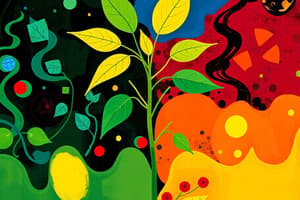Podcast
Questions and Answers
Which branch of botany focuses on the internal structure of plants?
Which branch of botany focuses on the internal structure of plants?
- Plant Taxonomy
- Plant Anatomy (correct)
- Plant Physiology
- Plant Ecology
What is the main function of leaves in plants?
What is the main function of leaves in plants?
- Anchor the plant
- Conduct photosynthesis (correct)
- Facilitate pollination
- Support the plant
What pigment is critical for absorbing light during photosynthesis?
What pigment is critical for absorbing light during photosynthesis?
- Flavonoids
- Carotenoids
- Chlorophyll (correct)
- Xanthophylls
In plant classification, which group does not possess xylem and phloem?
In plant classification, which group does not possess xylem and phloem?
Which process occurs during the Calvin Cycle?
Which process occurs during the Calvin Cycle?
What type of reproduction involves the formation of seeds?
What type of reproduction involves the formation of seeds?
Which of the following is a primary role of plants in the ecosystem?
Which of the following is a primary role of plants in the ecosystem?
What method can be used for seed dispersal?
What method can be used for seed dispersal?
Flashcards are hidden until you start studying
Study Notes
Overview of Botany
- Definition: The scientific study of plants, including their structure, properties, biochemical processes, classification, and interactions with their environment.
- Branches of Botany:
- Plant Anatomy: Study of the internal structure of plants.
- Plant Physiology: Examination of plant functions and processes.
- Plant Ecology: Study of the relationships between plants and their environment.
- Plant Taxonomy: Classification and naming of plants.
- Plant Pathology: Study of plant diseases and their causes.
Plant Structure
- Roots: Anchor plants, absorb water and nutrients.
- Stems: Support the plant, transport nutrients and water between roots and leaves.
- Leaves: Main site of photosynthesis; contain chlorophyll.
- Flowers: Reproductive structures that facilitate pollination and seed production.
- Fruits: Mature ovary of a flower, containing seeds.
Photosynthesis
- Process by which plants convert light energy into chemical energy.
- Main components:
- Chlorophyll: Green pigment critical for absorbing light.
- Light Reactions: Convert solar energy into chemical energy (ATP and NADPH).
- Calvin Cycle: Uses ATP and NADPH to convert CO2 into glucose.
Plant Classification
- Kingdom Plantae: Divided into several groups based on characteristics.
- Non-Vascular Plants: Mosses and liverworts.
- Vascular Plants: Have xylem and phloem; includes ferns, gymnosperms, and angiosperms.
- Angiosperms: Flowering plants; divided into monocots and dicots.
Plant Reproduction
- Asexual Reproduction: Involves vegetative propagation (e.g., runners, tubers).
- Sexual Reproduction: Involves the formation of seeds through pollination and fertilization.
- Pollination: Transfer of pollen from male to female parts of flowers.
- Seed Dispersal: Mechanisms include wind, water, and animals.
Importance of Botany
- Ecological Role: Plants are primary producers, forming the base of food chains.
- Medicinal Uses: Source of many pharmaceuticals and traditional remedies.
- Agriculture: Understanding plant biology leads to improved crop yields and sustainability.
- Environmental Impact: Studying plants helps address issues like climate change and habitat loss.
Overview of Botany
- Scientific study focused on plants' structure, properties, biochemical processes, classification, and environmental interactions.
- Key branches include:
- Plant Anatomy: Analyzes internal structures of various plant types.
- Plant Physiology: Investigates physical functions and biological processes within plants.
- Plant Ecology: Explores how plants interact with their surrounding environment.
- Plant Taxonomy: Involves the classification and naming conventions of plant species.
- Plant Pathology: Examines diseases in plants, identifying causes and effects.
Plant Structure
- Roots: Stabilize plants while absorbing essential water and nutrients from the soil.
- Stems: Provide physical support, acting as conduits for nutrient and water transport between roots and leaves.
- Leaves: Primary sites for photosynthesis, containing chlorophyll which captures light energy.
- Flowers: Serve reproductive purposes, facilitating the processes of pollination and seed generation.
- Fruits: Develop from mature ovaries of flowers and contain seeds critical for plant reproduction.
Photosynthesis
- Fundamental process through which plants convert sunlight into chemical energy.
- Key components involved include:
- Chlorophyll: Green pigment vital for light absorption during photosynthesis.
- Light Reactions: Initial phase converting solar energy into chemical forms (ATP and NADPH).
- Calvin Cycle: Second phase that uses ATP and NADPH to transform carbon dioxide (CO2) into glucose.
Plant Classification
- Kingdom Plantae: Organized into groups based on distinguishing characteristics.
- Non-Vascular Plants: Includes types such as mosses and liverworts, lacking vascular tissues.
- Vascular Plants: Possess xylem and phloem; categories include ferns, gymnosperms, and angiosperms.
- Angiosperms: Flowering plants categorized further into two major types: monocots and dicots.
Plant Reproduction
- Asexual Reproduction: Involves vegetative methods such as runners and tubers for plant propagation.
- Sexual Reproduction: Relies on seed formation through processes of pollination and fertilization.
- Pollination: Transfer of pollen is necessary for fertilization in flowering plants.
- Seed Dispersal: Various mechanisms exist including wind, water, and animals to distribute seeds for growth.
Importance of Botany
- Ecological Role: Plants serve as primary producers, forming foundational elements of terrestrial food chains.
- Medicinal Uses: Provide crucial resources for pharmaceuticals and traditional medicine.
- Agriculture: Knowledge of plant biology enables advancements in crop yields and sustainable farming practices.
- Environmental Impact: Insights from plant studies contribute to solutions for climate change and habitat preservation challenges.
Studying That Suits You
Use AI to generate personalized quizzes and flashcards to suit your learning preferences.




